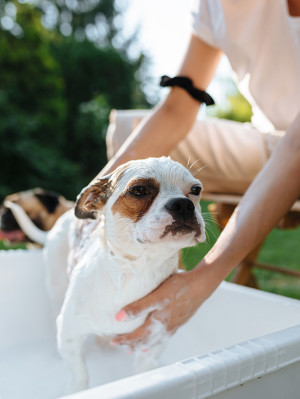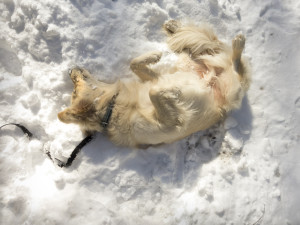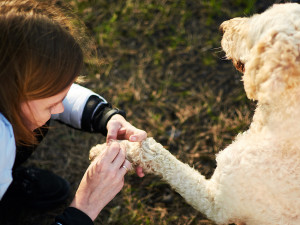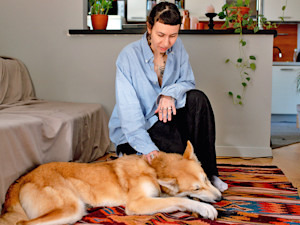Hot Spots in Dogs: What Are They, How to Treat Them, and How They Compare to Ringworm
From home treatments to holistic methods—and when to call a vet.
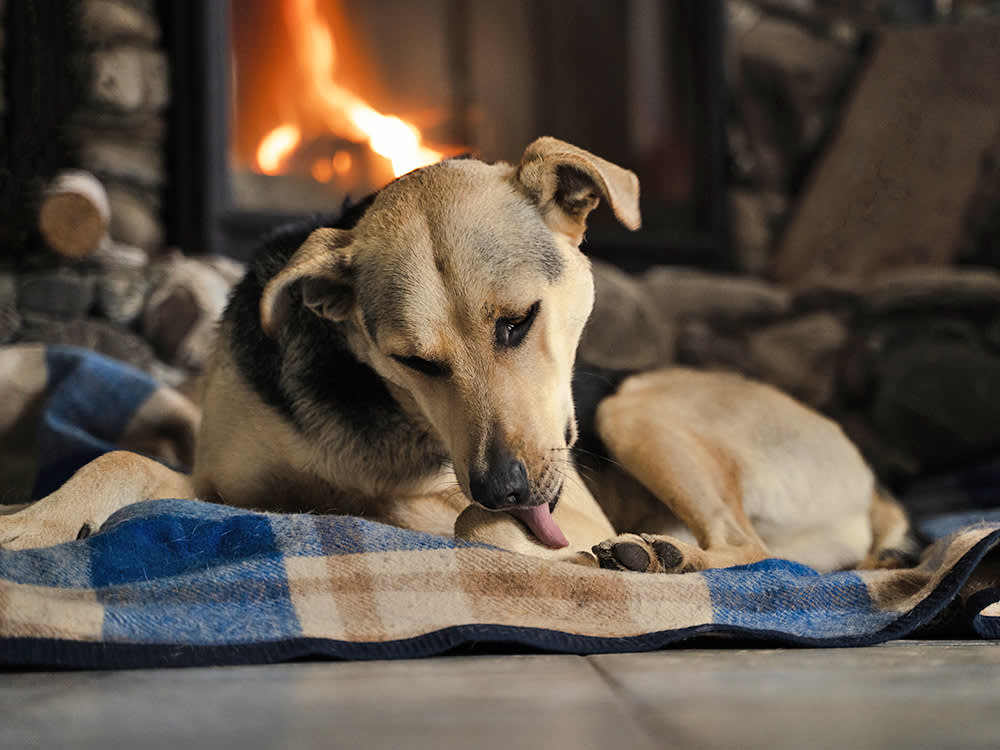
Share Article
In This Article:
What Are Dog Hot Spots? How Are Hot Spots Diagnosed? Dog Hot Spots vs. Ringworm Treatment Options for Dog Hot Spots Preventing Hot Spots in Dogs
Hot spots in dogs — also known as acute moist dermatitis or pyotraumatic dermatitis — are a common skin condition. They most often appear as red, inflamed, and irritated areas. They can also appear suddenly and enlarge quickly, which can be frustrating for you and your dog.
Hot spots can cause tremendous discomfort for your dog who may lick or scratch them, which can worsen the condition. Although hot spots can look scary, they are generally superficial and are the result of chewing or scratching due to allergies, insect bites, or poor grooming. They can appear quite similar to other skin conditions, including ringworm, so it’s essential to identify them and treat them properly. Understanding the distinctions between these conditions and how to treat hot spots can help ensure your dog’s skin stays healthy and itch-free.
Main takeaways
Hot spots are common in dogs, appearing as red, inflamed, irritated areas of skin.
They have various causes, but all are made worse by your dog licking them.
Hot spots, which are different from ringworm, are diagnosed by appearance and sometimes tests by your vet.
Hot spots can be treated at home, by your vet, or through holistic methods — and they can also be prevented.
What are dog hot spots?
Dog hot spots are red, inflamed, and often infected areas of your dog’s skin that begin as small red spots and quickly enlarge due to your dog licking and scratching them. There is hair loss on top, either complete or partial.
How much do you spend on your pet per year?

Hot spots can appear anywhere on the body, but are most common on the head, limbs, and rear end. They are more prevalent in certain breeds but can affect any dog. They can look very similar to several other skin conditions, so it is essential to identify them to treat them appropriately. Often, you may need to explore an underlying cause to prevent hot spots from becoming a chronic issue.
Signs and symptoms
The first sign you may notice is your dog constant itching and scratching at a particular area of the skin. This can have a very rapid onset. Other symptoms include:
A red, inflamed localized area of the skin that feels warm to the touch
A moist or oozing area that may appear shiny
Patches of missing fur around the site
Foul odor due to a secondary bacterial infection
Possible swelling, scabbing, or crusty edges
If not correctly treated, the area will enlarge over time. Depending on the stage of development, you may treat a hot spot at home or take your dog to your veterinarian.
Causes of hot spots
Hot spots are most often caused by your dog’s biting and licking, causing trauma to an area of skin. The initial underlying cause of the itchiness can include:
Allergies: Anything your dog is allergic to that causes intense itching can lead to a hot spot. This can include atopic allergies, such as pollen from grasses, trees, or weeds, dust mites, mold spores, animal dander, feathers, cleaning products or fragrances, and pollution or smoke. It can also include food, contact, flea, and drug allergies.
Parasites and infection: Any insect bite (especially fleas, ticks, and mites) can irritate an area on the skin that causes your dog to scratch or lick it.
Environmental factors: Moisture trapped in your dog’s fur creates an ideal environment for bacterial growth. High humidity and moisture are an especially inviting environment for a hot spot. (Warm, humid climates put your dog at risk.) Dogs who remain wet after swimming or being bathed are prone to hot spots. If your dog is damp from a rain shower and left free to dry, that is an invitation for a hot spot.
Breed type: Certain dog breeds are more prone to retaining moisture due to their thick, long fur, sensitivity to allergies, or floppy ears. They include Golden Retrievers, Labrador Retrievers, German Shepherds, Rottweilers, Saint Bernards and Newfoundlands, Bernese Mountain Dogs, and Cocker Spaniels.
Dog-collar skin irritation: Wearing specific collars or harnesses can lead to hot spots in certain dogs.
Poor grooming: Dirty or matted fur caused by a buildup of dirt and debris can irritate the skin and encourage bacteria to thrive.
Stress: Dogs without adequate mental stimulation may lick or chew their skin excessively, creating hot spots.
How are hot spots diagnosed?
Often, hot spots can be diagnosed just by their appearance and your dog’s symptoms. Visual symptoms include:
Red, irritated areas of skin, often round or irregular in shape
A wet or shiny appearance
Missing fur around the hot-spot area
Swelling
A crusty layer or scabs around the edges
In addition, you may smell a foul odor due to secondary bacterial infections. A history of moist skin, allergies, irritation, matted fur, or stress can also be telling. If your vet cannot obtain a diagnosis just by appearance, they will suggest some diagnostic tests.
When to visit the vet
While you can often treat mild hot spots at home, there are situations where a visit to the veterinarian is necessary. Consult your vet if:
The hot spot is enlarging rapidly or is extensive
Your dog is in significant distress
A foul odor, excessive pus, or swelling occurs
Your dog gets frequent hot spots
The hot spot doesn’t improve after a few days of home care
There are hot spots near your dog’s eyes, ears, or genitals
Tests and examinations
Your vet will conduct a thorough examination and possibly recommend some additional tests.
A skin scraping to obtain a small sample of skin cells will check for mites or other parasites.
Cytology — swabbing the hot spot to examine cells, bacteria, or fungi under a microscope — will help identify infection or inflammation.
Flea combing will help check for fleas or flea dirt.
If it is not your pup’s first hot spot, your vet may suggest more extensive tests. These include allergy testing (either by blood or intradermal testing), a fungal culture (for ringworm), bacterial culture and sensitivity (for severe or recurrent infections), and blood work with a CBC and chemistry panel (to spot hormonal imbalances or autoimmune conditions).
Dog hot spots vs. ringworm
People often think their dog may have ringworm when it is actually a hot spot. There are almost no similarities between them, except that both conditions are found in the skin, involve hair loss, and are, to some degree, red. Other than that, there are many differences distinguishing the two, including distinct causes, symptoms, and treatments.
What is the difference between ringworm and hot spots?
There are, in fact, many differences between ringworm and hot spots.
The cause of hot spots is self-trauma caused by excessive licking, scratching, or chewing. Ringworm is a fungal infection that affects the skin, hair, or nails and is contagious to people or other animals.
Hot spots are red, moist, inflamed, and sometimes oozing. They can also have a foul odor. Ringworm is almost always circular and presents as dry, scaly patches of hair loss with a red, inflamed edge and a less inflamed center.
The symptoms of hot spots are intense itching accompanied by licking or chewing at the site. The area is usually warm and swollen. Ringworm causes mild itching and a more gradual progression of hair loss with scaly lesions that may be accompanied by oozing.
The hot spots are usually located anywhere your dog can reach to lick or scratch, while ringworm can appear anywhere on the body.
Hot spots are not contagious to people or other pets. Ringworm is highly contagious and can be spread to other pets and humans through direct contact or contaminated surfaces.
Hot spots are primarily diagnosed by appearance, although secondary bacterial infections may require cytology or bacterial culture. Ringworm is diagnosed with a fungal culture, a special light called a Wood’s lamp (which is not as reliable), or a microscopic analysis of hair or skin samples.
How does treatment vary for hot spots vs. ringworm?
Treatment is vastly different for hot spots and ringworm. Additionally, administering the wrong treatment to each one can make them worse.
For hot spots, the treatment includes topical or oral antibiotics, anti-inflammatory medications, and cleaning the area. Ringworm treatment involves topical or oral antifungal medications and environmental decontamination.
Treatment options for dog hot spots
There are various methods of treating dog hot spots. You can treat them at home, seek veterinary assistance, or try natural and holistic approaches.
At-home remedies
It’s possible to treat mild hot spots at home if they’re caught early. Clipping the fur around the hot spot is essential first to expose the area. This will prevent trapped moisture and additional irritation.
After trimming, gently clean the area with warm water and iodine, or diluted chlorhexidine. Pat dry as thoroughly as possible. Remember, moisture worsens hot spots. To promote healing, apply pure aloe vera gel, chamomile tea compresses, or coconut oil. Make your dog wear an Elizabethan collar, aka cone, or soft recovery collar to prevent licking and scratching. Check for an underlying cause, such as fleas or mats, and groom your dog regularly.
Medications and professional treatments
If your dog’s hot spot isn’t clearing up or is worsening, it’s essential to make a vet appointment immediately. Your vet will do much of the same treatment you did at home: clip, clean, dry, and put a cone on your dog. However, your vet will also prescribe additional medications (including topical or oral antibiotics and anti-inflammatory medications), and if necessary, they will get a bacterial sample of the area to suggest an appropriate antibiotic. Your veterinarian may likewise recommend skin scrapings, cytology, allergy testing, and blood work to determine the underlying cause.
Natural and holistic approaches
Natural and holistic approaches can effectively manage hot spots in dogs, particularly when combined with proper hygiene and addressing underlying causes. Here are some strategies.
Apply pure aloe vera to the area to soothe and promote healing.
Calendula spray or ointment is known for its anti-inflammatory and anti-bacterial properties.
Coconut oil can help moisturize the area and fight bacteria.
Apple cider vinegar (diluted) can serve as a soothing spray.
Green tea compresses will reduce inflammation and irritation.
Omega-3 fatty acids from fish oil or flaxseed oil added to your dog’s food can reduce inflammation.
Probiotics can support immune function.
Address possible food allergies by feeding them a hypoallergenic diet.
Reduce stress through calming supplements such as chamomile, valerian root, or L-theanine. Also, increase environmental enrichment to alleviate boredom or anxiety.
Maintain regular grooming and flea control.
Monitor the hot spot closely. If it is not improving or is worsening, see your veterinarian.
Preventing hot spots in dogs
While hot spots cannot always be prevented, you can take many actions to try to avoid them.
Diet and supplements
Always provide your pet with a well-balanced diet that includes high-quality proteins and omega fatty acids. This will help maintain overall health and support strong skin barriers. If your dog has food allergies or sensitivities, try a limited-ingredient or hypoallergenic diet to avoid skin irritation. Include fresh veggies such as sweet potatoes, carrots, and lean meats to incorporate natural vitamins and antioxidants into your dog’s diet.
Several supplements can help prevent hot spots, including:
Omega-3 fatty acids
Probiotics
Vitamin E
Zinc
Biotin
Turmeric (curcumin)
Collagen or gelatin
Coconut oil
Consult your veterinarian before giving your dog any supplements and to determine dosages.
Grooming and hygiene
Keeping both your dog and the environment around them clean will go a long way toward preventing hot spots. Here’s a review of the actions we have noted that will help those pesky skin problems go away.
Brush your dog regularly, daily, or at least a few times weekly.
Bathe as necessary, but avoid over-bathing. Groomers recommend bathing every four to six weeks.
Use a gentle, hypoallergenic, or medicated shampoo.
Keep your dog’s coat dry after bathing, swimming, or exposure to rain.
Regularly trim the fur in areas such as the ears, tail, and belly, which are more prone to matting and moisture retention.
Check for fleas, ticks, and other parasites regularly and use a vet-recommended flea- and tick-prevention method.
Clean ears and skin folds, especially in breeds with floppy ears or excessive skin folds.
Trim your dog’s nails regularly.
When you groom your dog, check for areas of redness or irritation to catch hot spots at a very early stage.
Maintain a clean environment. Wash grooming tools, toys, and bedding regularly.
Following the above tips can help keep your dog’s skin healthy and more resistant to developing hot spots.
Environment and lifestyle changes
Making environment and lifestyle changes can significantly reduce the likelihood of hot spots in dogs by addressing triggers and maintaining overall skin health. Here are strategies aimed at minimizing or avoiding hot spots.
Vacuum often and regularly clean bedding, toys, and blankets to keep your dog’s living space clean.
Provide proper ventilation by controlling your home temperature, as well as using fans and dehumidifiers.
Prevent flea and tick infestations with regular prevention and yard maintenance.
Provide mental and physical stimulation with daily exercise and enrichment activities.
Avoid moisture trapping by thoroughly drying your dog and getting them regularly groomed.
Reduce exposure to allergens by decreasing outdoor time, using hypoallergenic bedding, and eliminating irritants.
Try to reduce your dog’s anxiety and stress.
Ensure your dog eats a proper diet, including omega-3 fatty acids and other supplements recommended by your vet.
Avoid overly rough play.
Schedule regular check-ups.
Implementing these environmental and lifestyle changes can significantly reduce the triggers that lead to hot spots, keeping your dog comfortable and healthy.
FAQs
Will a hot spot heal on its own?
If the original irritation is minor and your dog leaves it alone, a hot spot could heal on its own.
Can hot spots spread to humans or other pets?
No, hot spots are not contagious to humans or other pets.
How long does it take for hot spots to heal?
It depends on how severe the hot spot is. A mild-to-moderate hot spot can heal in approximately seven to 10 days with proper treatment, while a severe, infected hot spot can take two to three weeks.
Resources
“Hot Spots.” Cornell University College of Veterinary Medicine, 2024, www.vet.cornell.edu/departments-centers-and-institutes/riney-canine-health-center/canine-health-information/hot-spotsopens in new tab.
Ihrke, P.J. “An Overview of Bacterial Skin Disease in the Dog.” British Veterinary Journal, vol. 143, no. 2, Mar. 1987, pp. 112–118, https://doi.org/10.1016/0007-1935(87)90002-9opens in new tab. Accessed 29 Jan. 2022.
“Pyotraumatic Dermatitis (Acute Moist Dermatitis, Hot Spot).” Veterinary Practice, www.veterinary-practice.com/article/pyotraumatic-dermatitis-acute-moist-dermatitis-hot-spotopens in new tab.

Dr. Shea Cox, DVM, CVPP, CHPV
Dr. Shea Cox is the founder of BluePearl Pet Hospice and is a global leader in animal hospice and palliative care. With a focus on technology, innovation and education, her efforts are changing the end-of-life landscape in veterinary medicine.

Dr. Bartley Harrison, DVM
Dr. Bartley Harrison is a veterinarian with more than 19 years of experience. He has treated a variety of species in emergency and speciality practices for both large and small animals. His primary interests as a vet are emergency medicine and critical care.

Dr. Shelby Neely, DVM
Dr. Shelby Neely is a freelance writer and veterinarian who graduated from the University of Pennsylvania School of Veterinary Medicine and has practiced veterinary medicine for 30 years, specializing in small animals. Her work has appeared in Allivet, AsktheCatDoctor, WhiskerDocs, Ask the Cat Doctor Radio, Ask the Cat Doctor TV, and numerous other websites, brochures, newsletters, newspapers, and ebooks. In her spare time, Dr. Neely likes to spend time with her three children, two grandchildren, three cats, two grand-cats, and five grand-dogs.
Related articles
![a Chihuahua dog licking their paw]()
Why Do Dogs Lick Their Paws?
Their toes might smell like Fritos, but there’s no way they taste that good.
![A woman checking out her dogs paw.]()
Here’s Where Disease-Carrying Ticks Are in the US—And How to Keep Your Pup Safe
Simple preventive steps can go a long way toward offsetting their threats.
Can Dogs Get Skin Tags? Causes and Treatments
Yes, and here’s why you shouldn’t pick at them, even if you want to.
![Woman rubbing her dog's back at home.]()
Why Does Your Dog Have Bumps on Their Back?
Hmm, those weren’t always there...
![Fluffy brown and white puppy dog scratching a lot with its paw]()
Your Itchy Dog Deserves Relief—Here’s What to Do
Thankfully, there are treatments. But first, you have to figure out why they have an itch to scratch.
Can Dogs Get Sunburns? Signs, Treatment
It’s good to know ahead of all the summer fun you’re gonna have together.

